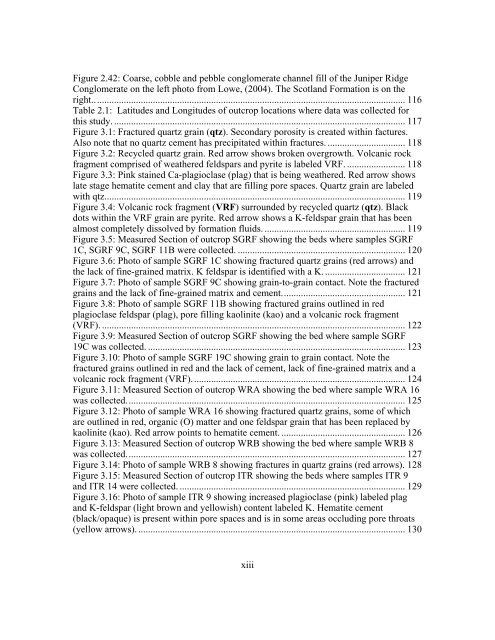Copyright by Nysha Chaderton 2009 - The University of Texas at ...
Copyright by Nysha Chaderton 2009 - The University of Texas at ...
Copyright by Nysha Chaderton 2009 - The University of Texas at ...
You also want an ePaper? Increase the reach of your titles
YUMPU automatically turns print PDFs into web optimized ePapers that Google loves.
Figure 2.42: Coarse, cobble and pebble conglomer<strong>at</strong>e channel fill <strong>of</strong> the Juniper Ridge<br />
Conglomer<strong>at</strong>e on the left photo from Lowe, (2004). <strong>The</strong> Scotland Form<strong>at</strong>ion is on the<br />
right................................................................................................................................. 116<br />
Table 2.1: L<strong>at</strong>itudes and Longitudes <strong>of</strong> outcrop loc<strong>at</strong>ions where d<strong>at</strong>a was collected for<br />
this study. ........................................................................................................................ 117<br />
Figure 3.1: Fractured quartz grain (qtz). Secondary porosity is cre<strong>at</strong>ed within factures.<br />
Also note th<strong>at</strong> no quartz cement has precipit<strong>at</strong>ed within fractures. ................................ 118<br />
Figure 3.2: Recycled quartz grain. Red arrow shows broken overgrowth. Volcanic rock<br />
fragment comprised <strong>of</strong> we<strong>at</strong>hered feldspars and pyrite is labeled VRF. ........................ 118<br />
Figure 3.3: Pink stained Ca-plagioclase (plag) th<strong>at</strong> is being we<strong>at</strong>hered. Red arrow shows<br />
l<strong>at</strong>e stage hem<strong>at</strong>ite cement and clay th<strong>at</strong> are filling pore spaces. Quartz grain are labeled<br />
with qtz............................................................................................................................ 119<br />
Figure 3.4: Volcanic rock fragment (VRF) surrounded <strong>by</strong> recycled quartz (qtz). Black<br />
dots within the VRF grain are pyrite. Red arrow shows a K-feldspar grain th<strong>at</strong> has been<br />
almost completely dissolved <strong>by</strong> form<strong>at</strong>ion fluids. .......................................................... 119<br />
Figure 3.5: Measured Section <strong>of</strong> outcrop SGRF showing the beds where samples SGRF<br />
1C, SGRF 9C, SGRF 11B were collected. ..................................................................... 120<br />
Figure 3.6: Photo <strong>of</strong> sample SGRF 1C showing fractured quartz grains (red arrows) and<br />
the lack <strong>of</strong> fine-grained m<strong>at</strong>rix. K feldspar is identified with a K. ................................. 121<br />
Figure 3.7: Photo <strong>of</strong> sample SGRF 9C showing grain-to-grain contact. Note the fractured<br />
grains and the lack <strong>of</strong> fine-grained m<strong>at</strong>rix and cement................................................... 121<br />
Figure 3.8: Photo <strong>of</strong> sample SGRF 11B showing fractured grains outlined in red<br />
plagioclase feldspar (plag), pore filling kaolinite (kao) and a volcanic rock fragment<br />
(VRF). ............................................................................................................................. 122<br />
Figure 3.9: Measured Section <strong>of</strong> outcrop SGRF showing the bed where sample SGRF<br />
19C was collected. .......................................................................................................... 123<br />
Figure 3.10: Photo <strong>of</strong> sample SGRF 19C showing grain to grain contact. Note the<br />
fractured grains outlined in red and the lack <strong>of</strong> cement, lack <strong>of</strong> fine-grained m<strong>at</strong>rix and a<br />
volcanic rock fragment (VRF)........................................................................................ 124<br />
Figure 3.11: Measured Section <strong>of</strong> outcrop WRA showing the bed where sample WRA 16<br />
was collected................................................................................................................... 125<br />
Figure 3.12: Photo <strong>of</strong> sample WRA 16 showing fractured quartz grains, some <strong>of</strong> which<br />
are outlined in red, organic (O) m<strong>at</strong>ter and one feldspar grain th<strong>at</strong> has been replaced <strong>by</strong><br />
kaolinite (kao). Red arrow points to hem<strong>at</strong>ite cement. ................................................... 126<br />
Figure 3.13: Measured Section <strong>of</strong> outcrop WRB showing the bed where sample WRB 8<br />
was collected................................................................................................................... 127<br />
Figure 3.14: Photo <strong>of</strong> sample WRB 8 showing fractures in quartz grains (red arrows). 128<br />
Figure 3.15: Measured Section <strong>of</strong> outcrop ITR showing the beds where samples ITR 9<br />
and ITR 14 were collected. ............................................................................................. 129<br />
Figure 3.16: Photo <strong>of</strong> sample ITR 9 showing increased plagioclase (pink) labeled plag<br />
and K-feldspar (light brown and yellowish) content labeled K. Hem<strong>at</strong>ite cement<br />
(black/opaque) is present within pore spaces and is in some areas occluding pore thro<strong>at</strong>s<br />
(yellow arrows). .............................................................................................................. 130<br />
xiii
















